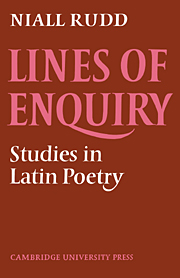Book contents
- Frontmatter
- Contents
- Preface
- Abbreviations
- 1 HISTORY: Ovid and the Augustan myth
- 2 IDEA: Dido's culpa
- 3 IMITATION: association of ideas in Persius
- 4 TONE: poets and patrons in Juvenal's seventh satire
- 5 ARCHITECTURE: theories about Virgil's Eclogues
- 6 THEORY: sincerity and mask
- 7 TRANSLATION
- Index of writers, scholars and translators
3 - IMITATION: association of ideas in Persius
Published online by Cambridge University Press: 07 January 2010
- Frontmatter
- Contents
- Preface
- Abbreviations
- 1 HISTORY: Ovid and the Augustan myth
- 2 IDEA: Dido's culpa
- 3 IMITATION: association of ideas in Persius
- 4 TONE: poets and patrons in Juvenal's seventh satire
- 5 ARCHITECTURE: theories about Virgil's Eclogues
- 6 THEORY: sincerity and mask
- 7 TRANSLATION
- Index of writers, scholars and translators
Summary
Readers of Persius have always recognized that he owed a special debt to Horace. In the appendix to his edition of 1605 Casaubon noted most of the important allusions, and later editors like Conington and Villeneuve made excellent use of this material when commenting on individual points. In recent times attention has come to focus more upon the way in which the allusions are made. In the first section of his Berlin dissertation (1940) Kugler showed how in a number of cases Persius gave a literal meaning to a Horatian metaphor. Then in Philologus 1955 Henss distinguished ten ways in which Persius varied his Horatian material – e.g. by altering plural to singular, putting species for genus, and switching from active to passive voice. Here is an example of his procedure:
Horace, Epist. 1.16.64: in triuiis fixum cum se demittit ob assem
Persius 5.111: inque luto fixum possis transcendere nummum
‘Both poets want to show in this picture a miser in a particularly degrading situation: picking up a cheap coin which is stuck in the mud of the street. Horace says “stuck in the street”, meaning “in the mud of the street”. The idea of sticky mud is demanded by the word fixum. Persius allows “street” to be understood, substituting for it the lutum, which is now made explicit.’
This is an illustration of what Henss calls Auflösung der Prägnanz – making implications explicit. Henss' paper, which is admirably perceptive and lucid, is concerned above all with classification.
- Type
- Chapter
- Information
- Lines of EnquiryStudies in Latin Poetry, pp. 54 - 83Publisher: Cambridge University PressPrint publication year: 1976
- 2
- Cited by



